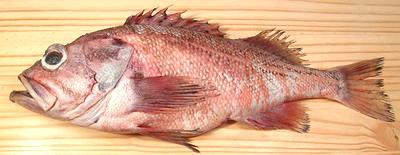 [Blacktip Rockcod; Sebastes aleutianus]
[Blacktip Rockcod; Sebastes aleutianus]
This Pacific rockfish is found from the northern tip of Japan all the way around and down to San Diego, California but is most populous along the south coast and islands of Alaska and off the coast of Washington state. It gets its name from a row of tiny spines found right under the eyes. This fish can live for over 140 years and can grow to 38 inches and 19 pounds, but the photo specimen was 19 inches and 3 pounds 4 ounces. It can often be found in Asian groceries in Southern California. Fishing regulations for rockfish are quite strict, limiting supply, so they are unlikely to be found in markets far from the Pacific Coast.
More on Rockfish
Rougheye Rockfish is an excellent eating fish with white, moderately flavored flesh that is tender but holds together well with any cooking method. It's easy to eliminate all the bones, and on the plate it separates easily into large flakes.
Cleaning: No particular problems cleaning this fish. The scales are fairly large and easy to scrape off without a lot of flying around. There are a few that stick hard on the lateral line and would need to be pulled off with long nose pliers only if you intend to leave the skin on.
Use your filleting knife, sharp edge out, to cut from the vent to the fins, then your kitchen shears to cut from the fins up to the chin. You will have to use your kitchen shears to cut the esophagus and the ends of the gill arches, and a few other spots, mainly because this is a large fish.
Fillet: Rougheye Rockfish is rather easy to fillet, with easy to follow fin rays and bones.
Note that the skirt area often has a strong "off" flavor, particularly if the inside lining is dark and muddy looking. If so, it should be discarded.
Skin: The skin shrinks severely when heated (as does the membrane lining the body cavity) but it's a very easy fish to skin using the long knife and cutting board technique. While skin must be removed from fillets so it will not destroy them, you can bake a moderate size fish whole, but do make a few diagonal slashes half way through the flesh so the skin won't tear it up and make it look really ugly. Those cuts will open up wide, but that just lets the sauce in.
Cooking: This fish holds together well enough for all common methods of cooking. If you poach fillets, even though they have been skinned they will curl fairly strongly to the skin side. It is best to split them in half lengthwise and have long pieces rather than wide pieces. If pan frying, keep in mind these fillets, especially at the head end, are very thick, so fry over rather low heat so they're cooked through by time they're browned.
Yield: A 3 pound 3-3/4 ounce fish yielded fillets weighing 1 pound 8-1/4 ounces skin-on fillet (47%), 1 pound 6-1/8 ounces skin-off (43%), which is very good for a large head fish like this. A smaller fish will yield a bit less, a larger fish a bit more.
Stock: The head, bones and fins make a light flavored stock that would be quite desirable, except it's murky and a gray-brown color that isn't at all attractive.
sf_rockrez 100411 - www.clovegarden.com